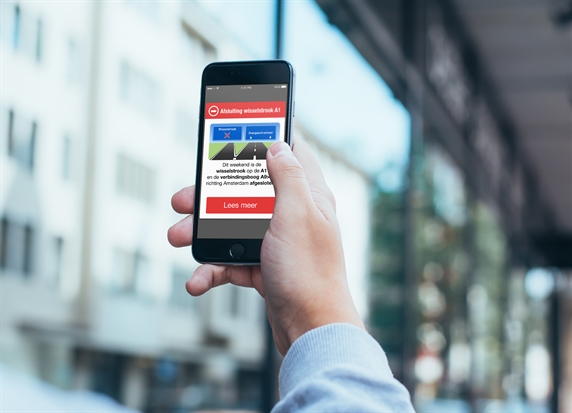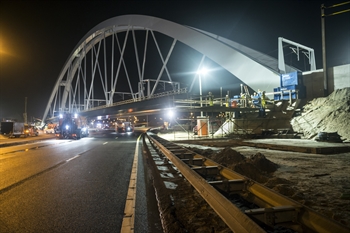Case study In-app notifications deployed at Schiphol, Amsterdam, Almere (SAA)
In the Schiphol-Amsterdam-Almere (SAA) programme, service providers Innovactory and Be-Mobile trace road users in the vicinity of an (expected) congestion peak. Based on their location, both prior to and during the congestion peak, these road users receive a message on their mobile telephones, announcing the roadworks.
The road users receive the messages via the TimesUpp app (from Innovactory) or Flitsmeister (from Be-Mobile). The content of the message depends on the location and the nature of the roadworks. A link in the in-app notifications allows users to go to the SAA online visitor centre. Here, background information is provided about the roadworks and alternative routes.
Background and purpose
The road network between Schiphol, Amsterdam and Almere is being expanded. To limit disruption during these roadworks as far as possible, SAA has been using in-app notifications since 2014. The project team works according to the principle of 'location-based warnings'. This represents an attractive form of public-private partnership. The aim of SAA's efforts is to provide as many road users as possible with targeted information about the road works prior to departure. This allows them to be prepared and make smart choices.

Scope and effect
The measurable reach can fluctuate but when deployed on a busy SAA corridor like the A9 or A1 motorways, it can easily reach 50,000 unique users. Around 10% will click on to the background information.
SAA has completed a series of pilot trials to determine the effect of the in-app notifications on traffic levels (compliance behaviour). Measuring this effect is difficult. However, the same applies to the effect of the more traditional vanAnaarBeter newspaper advertisement. For those advertisements too, there is no knowledge of how many people follow the advice given.
Points for consideration
- Ensure support within the project: the use of market parties is still new to many government authorities, and may create resistance.
- Internal harmonisation is essential: the deployment of in-app notifications is a combination of communication, traffic management and mobility management.
- Ensure tailor-made information: no two congestion peaks are the same. For the effective deployment of in-app notifications, government authorities and market parties must harmonise smoothly.
- Start on time. For each first use, set aside at least a couple of months for preparation (creating support, the purchase process and correct deployment).
- Requesting method: for SAA, this measure is requested from within the project. For other projects, the contractor will offer in-app notifications in the tender.
- Always be 100% correct: it is important that the information that is sent is precisely accurate or you run the risk of users dropping out.
- Do not use in-app notifications for disruptions in areas where few road users can be reached (coverage level).
- Road safety: there is public discussion about the use of smartphones in traffic. The government campaign ‘appen op een P’ (park up to use your smartphone) is just one example. Take this into account when deploying this measure. Flitsmeister, for example, only sends out an in-app notification on arrival at a destination.
- On-trip information: you can also deploy in-app notifications to draw attention to a new or temporary road situation. It is then important that the road user receives the message in-car. For that purpose, Flitsmeister has developed a system of spoken messages.
Can the measure be deployed more broadly?
In-app notifications have already been used in a number of different projects. Experience at SAA has shown that the measure works best for disruptions on the main road network and in busy areas operated by municipal or provincial road managers. The most important question to be asked before using in-app notifications is whether it is possible to reach large target groups.
The market for this theme is developing rapidly. The possibilities for the deployment of in-app notifications of this kind will certainly expand rapidly. If deployed on a new project, it is smart to first map out these developments, on the basis of the objectives and parameters within the project.

